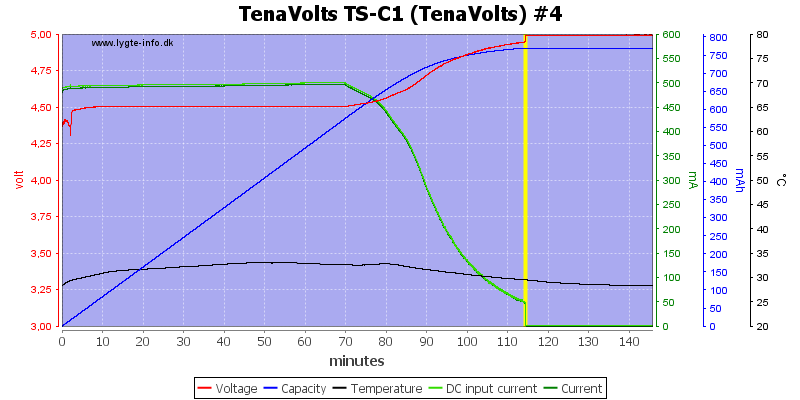TenaVolts AA 2775mW (Black-blue)
/DSC_9122.jpg)
Official specifications:
- Product model: NF-LB1
- Battery size: AA
- Charge capacity: 750mAh
- Energy capacity: 2775mWh
- Output voltage: 1.5V
- Battery weight: 18g
- Cycle times: >1000
- Operating temp.: 32-104°F
/TenaVolts%20AA%202775mW%20(Black-blue)-info.png)
This is 1.5V LiIon AA batteries with build in voltage conversion for LiIon voltage to 1.5V.
/DSC_9113.jpg)
/DSC_9114.jpg)
/DSC_9115.jpg)
/DSC_9116.jpg)
I got the batteries in a nice box with specification for both the batteries and the charger.
/DSC_9119.jpg)
The box contained four batteries, a charger, a USB cable and a instruction sheet for the charger.
/DSC_9123.jpg)
/DSC_9124.jpg)
/DSC_9125.jpg)
/DSC_9126.jpg)
/DSC_9127.jpg)
The ring on the bottom of the cell is transparent and will emit blue light while charging, but there is only one led making the light very uneven.
/TenaVolts%20AA%202775mW%20(Black-blue)-Capacity.png)
These batteries maintain 1.5V until they are empty.

There is no significant difference in capacity at low currents, this means the self discharge is very low.
/TenaVolts%20AA%202775mW%20(Black-blue)-CapacityTime.png)
/TenaVolts%20AA%202775mW%20(Black-blue)-CapacityTimeHours.png)
/TenaVolts%20AA%202775mW%20(Black-blue)-Energy.png)

The batteries do not have a hard current limit, but voltage will drop when the load is too high.

The internal resistance looks smooth for a electronic regulated battery.

The output will change little when load is applied or removed.

It looks like the buck regulator runs at about 1.4MHz. The noise is less than 30mVpp, but I cannot measure lower with the current setup.
Charger TS-C1
/DSC_9128.jpg)
/DSC_9129.jpg)
The charger is a box with a semitransparent lid.
/DSC_9130.jpg)
/DSC_9131.jpg)
/DSC_9132.jpg)
Power is connected to the micro USB input.
/DSC_9133.jpg)
Behind the lightning symbol is a green led to show the charger is powered.
/DSC_9137.jpg)
It has specifications on the bottom.
/DSC_9135.jpg)
/DSC_9136.jpg)
The slots are standard 2 level slots for AA/AAA batteries.
/DSC_0042.jpg)
/DSC_0044.jpg)
The TenaVolt are AA batteries.

The battery is charged with about 4.6V to 5V and uses an internal charge regulator, it will terminate the LiIon charge at around 50mA.



Not much difference with the other slots (The voltage varies slightly).

With four batteries the voltage is lower, this means slightly longer charge time.


But what happens if a Alkaline or NiMH battery is put into the charger? It looks like it has a PTC that will limit the current. Initially it may draw all the current the USB output can deliver but after a few seconds the current will be limited. This means a NiMH will be charged continuous with around 130mA. Alkaline will be charged with higher current!
Charger Tear-down
/DSC_0045.jpg)
I could break the charger open with a spudger.
/DSC_0046.jpg)
/DSC_0047.jpg)
There is two small circuit boards inside the charger and no electronic on this side.
/DSC_0048.jpg)
/DSC_0049.jpg)
/DSC_0050.jpg)
/DSC_0051.jpg)
On this side is 5 resistors and one LED, as the test shows above four of the resistors (R2..R5) are PTC's and the last resistor (R1: 10kOhm) is for the LED.
/DSC_0052.jpg)
/DSC_0053.jpg)
Conclusion
These batteries has less capacity than normal NiMH, but run at a higher voltage, making the energy about the same. This makes them ideal for most equipment that has trouble with NiMH batteries. They also weight considerable less than NiMH, this can be significant in some circumstances. There is one disadvantage: Battery meters do not work with them.
The requirement to use a special charger is a disadvantage, but if it is damaged or disappears it is possible to modify any AA USB charger for this purpose (Requires soldering skills).
Notes and links
Batteries and charger was supplied by TenaVolt for review.
How is the test done and how to read the charts
Compare to other AA/AAA batteries: Alkaline/NiMH/Lithium
/DSC_9122.jpg)
/TenaVolts%20AA%202775mW%20(Black-blue)-info.png)
/DSC_9113.jpg)
/DSC_9114.jpg)
/DSC_9115.jpg)
/DSC_9116.jpg)
/DSC_9119.jpg)
/DSC_9123.jpg)
/DSC_9124.jpg)
/DSC_9125.jpg)
/DSC_9126.jpg)
/DSC_9127.jpg)
/TenaVolts%20AA%202775mW%20(Black-blue)-Capacity.png)

/TenaVolts%20AA%202775mW%20(Black-blue)-CapacityTime.png)
/TenaVolts%20AA%202775mW%20(Black-blue)-CapacityTimeHours.png)
/TenaVolts%20AA%202775mW%20(Black-blue)-Energy.png)




/DSC_9128.jpg)
/DSC_9129.jpg)
/DSC_9130.jpg)
/DSC_9131.jpg)
/DSC_9132.jpg)
/DSC_9133.jpg)
/DSC_9137.jpg)
/DSC_9135.jpg)
/DSC_9136.jpg)
/DSC_0042.jpg)
/DSC_0044.jpg)







/DSC_0045.jpg)
/DSC_0046.jpg)
/DSC_0047.jpg)
/DSC_0048.jpg)
/DSC_0049.jpg)
/DSC_0050.jpg)
/DSC_0051.jpg)
/DSC_0052.jpg)
/DSC_0053.jpg)